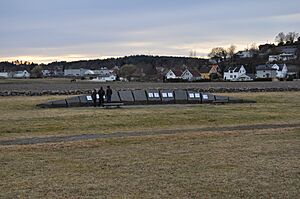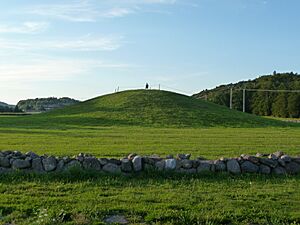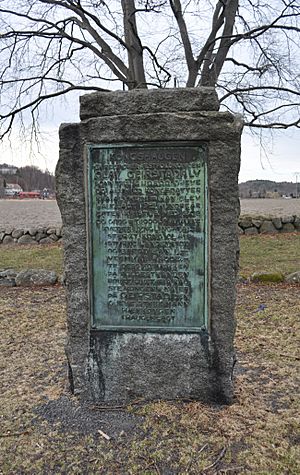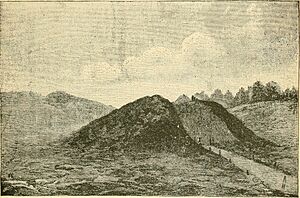Gokstad Mound facts for kids
The Gokstad Mound (also called Gokstadhaugen in Norwegian) is a very large burial mound in Sandefjord, Vestfold County, Norway. It is also known as the King's Mound. This is where the famous 9th-century Gokstad Ship was discovered.
Contents
Uncovering the Past: The Gokstad Mound's Story
A man named Nicolay Nicolaysen dug up the mound in 1880. The amazing Gokstad Ship was built around the year 890 AD. It was placed inside the mound about ten years later. The ship is mostly made of strong oak wood. It is about 23.8 meters (78 feet) long and 5.2 meters (17 feet) wide. It had 16 pairs of oars, and could sail quite fast, maybe up to twelve knots! Today, you can see the Gokstad Ship at the Viking Ship Museum in Oslo.
A Viking leader, sometimes called a "petty king," was buried with the ship. For a long time, people thought it was Olaf Geirstad-Alf. He was the half-brother of Halfdan the Black. But new discoveries have made it less clear who was buried there. So, it's still a mystery!
After two years of hard work to fix it up, the King's Mound was officially opened in July 1929. A small stone fence was built around the mound. Birch trees were planted along the fence. On July 20, 1929, between 2,000 and 3,000 people came to watch the opening. King Haakon VII was there, along with many important people from Norway. King Haakon VII even gave a speech!
The Gokstad Mound is considered one of Norway's best archaeological finds. In 2014, the Norwegian government asked UNESCO to make the Gokstad Mound a World Heritage Site. This would mean it's a very important place for everyone in the world.
Exploring the Excavation Site

In 1880, the mound was measured to be 50 meters (164 feet) wide. It was about 5 meters (16.4 feet) tall. During the Viking Age, the ocean water was much higher. It was almost 4 meters (13 feet) higher than it is today. This means the ship was probably buried very close to the sea.
Many interesting items were found in the grave. These included a gaming board with horn pieces, fishing hooks, and fancy harness parts. There were also 64 shields, kitchen tools, six beds, a sleigh, and three smaller boats. Even animals were buried there! Archaeologists found the remains of two peacocks, two goshawks (a type of bird), eight dogs, and twelve horses.
The burial room was covered with layers of birch bark. Tiny pieces of silk woven with gold thread were found stuck between the logs in the roof. These might have been part of a beautiful tapestry that decorated the walls inside.
Scientists have studied the wood from the ship. They found that the ship was built between the years 885 and 892 AD. The burial room itself was made ready between 895 and 903 AD.
The Viking chieftain buried in the mound was quite tall, about 181–183 cm (5'9"–6'0"). He was about 40 years old when he died, likely in a battle.
The ship was first discovered in 1879. Nicolay Nicolaysen led the digging work from April to June in 1880. The mound was later closed up. The chieftain's knuckles, which had been studied, were put back into the grave on June 16, 1928. They were placed in a special box called a sarcophagus. King Haakon VII was there for the official opening of the restored mound on July 29, 1929. In 2007, archaeologists took the sarcophagus out of the grave again. It is now kept at the University of Oslo (UiO).
See also
- Gaia ship
- Gokstad ship
Other sources
- Nicolaysen, Nicolay (1882) Langskibet Fra Gokstad Ved Sandefjord (Kristiania: Cammermeyer)






